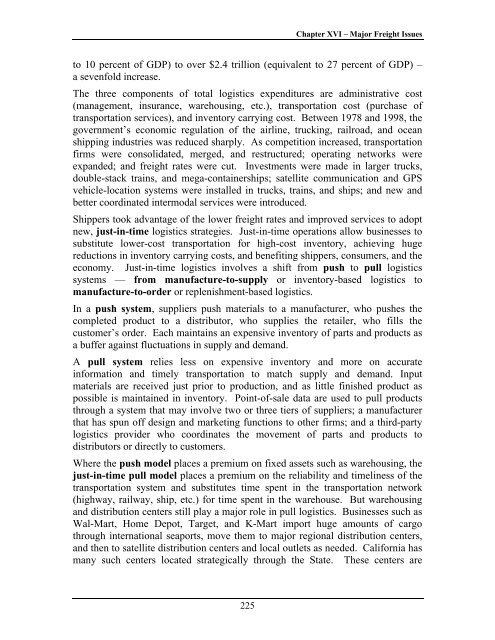California State Rail Plan 2007-08 to 2017-18
California State Rail Plan 2007-08 to 2017-18
California State Rail Plan 2007-08 to 2017-18
- No tags were found...
You also want an ePaper? Increase the reach of your titles
YUMPU automatically turns print PDFs into web optimized ePapers that Google loves.
Chapter XVI – Major Freight Issues<strong>to</strong> 10 percent of GDP) <strong>to</strong> over $2.4 trillion (equivalent <strong>to</strong> 27 percent of GDP) –a sevenfold increase.The three components of <strong>to</strong>tal logistics expenditures are administrative cost(management, insurance, warehousing, etc.), transportation cost (purchase oftransportation services), and inven<strong>to</strong>ry carrying cost. Between 1978 and 1998, thegovernment’s economic regulation of the airline, trucking, railroad, and oceanshipping industries was reduced sharply. As competition increased, transportationfirms were consolidated, merged, and restructured; operating networks wereexpanded; and freight rates were cut. Investments were made in larger trucks,double-stack trains, and mega-containerships; satellite communication and GPSvehicle-location systems were installed in trucks, trains, and ships; and new andbetter coordinated intermodal services were introduced.Shippers <strong>to</strong>ok advantage of the lower freight rates and improved services <strong>to</strong> adoptnew, just-in-time logistics strategies. Just-in-time operations allow businesses <strong>to</strong>substitute lower-cost transportation for high-cost inven<strong>to</strong>ry, achieving hugereductions in inven<strong>to</strong>ry carrying costs, and benefiting shippers, consumers, and theeconomy. Just-in-time logistics involves a shift from push <strong>to</strong> pull logisticssystems — from manufacture-<strong>to</strong>-supply or inven<strong>to</strong>ry-based logistics <strong>to</strong>manufacture-<strong>to</strong>-order or replenishment-based logistics.In a push system, suppliers push materials <strong>to</strong> a manufacturer, who pushes thecompleted product <strong>to</strong> a distribu<strong>to</strong>r, who supplies the retailer, who fills thecus<strong>to</strong>mer’s order. Each maintains an expensive inven<strong>to</strong>ry of parts and products asa buffer against fluctuations in supply and demand.A pull system relies less on expensive inven<strong>to</strong>ry and more on accurateinformation and timely transportation <strong>to</strong> match supply and demand. Inputmaterials are received just prior <strong>to</strong> production, and as little finished product aspossible is maintained in inven<strong>to</strong>ry. Point-of-sale data are used <strong>to</strong> pull productsthrough a system that may involve two or three tiers of suppliers; a manufacturerthat has spun off design and marketing functions <strong>to</strong> other firms; and a third-partylogistics provider who coordinates the movement of parts and products <strong>to</strong>distribu<strong>to</strong>rs or directly <strong>to</strong> cus<strong>to</strong>mers.Where the push model places a premium on fixed assets such as warehousing, thejust-in-time pull model places a premium on the reliability and timeliness of thetransportation system and substitutes time spent in the transportation network(highway, railway, ship, etc.) for time spent in the warehouse. But warehousingand distribution centers still play a major role in pull logistics. Businesses such asWal-Mart, Home Depot, Target, and K-Mart import huge amounts of cargothrough international seaports, move them <strong>to</strong> major regional distribution centers,and then <strong>to</strong> satellite distribution centers and local outlets as needed. <strong>California</strong> hasmany such centers located strategically through the <strong>State</strong>. These centers are225













